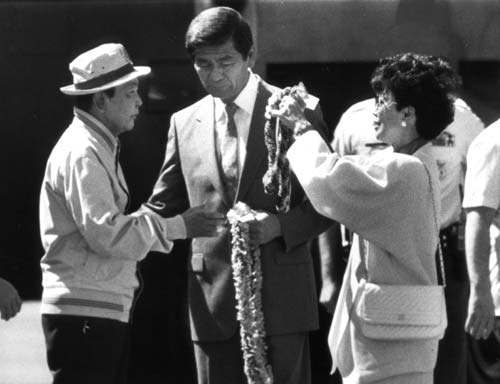Revolution resonates 25 years later

Jean Ariyoshi, right, prepared to drape a lei on Ferdinand Marcos as Gov. George Ariyoshi stood by with another lei after the deposed Philippine president landed at Hickam Air Force Base 25 years ago.
It was a peaceful revolution, one that, a quarter of century later, would serve as an example of a people ousting a dictator with little or no bloodshed.
Friday marks the 25th anniversary of the People Power Revolution that toppled the regime of former Philippine President Ferdinand Marcos.
Long before Egyptians protested in Cairo’s Tahrir Square, an estimated 2 million Filipinos converged at Epifanio de los Santos Avenue (commonly known as EDSA) in Manila beginning on Feb. 22, 1986, to protest the martial law and corruption of the Marcos regime.
On Feb. 25, 1986, Corazon Aquino, widow of slain opposition leader Benigno "Ninoy" Aquino Jr., was sworn in as president. The next day, Marcos, his family and members of his regime fled in exile to Honolulu, where Marcos lived until his death in September 1989.
"We set the tone for nonviolent revolutions. I think Filipinos can be proud of that," said Belinda Aquino, professor emeritus of the University of Hawaii at Manoa.
As the People Power Revolution’s anniversary draws near, Aquino (no relation to Corazon Aquino) and others have noted similarities and differences of the Philippine revolution with those in Egypt and, increasingly, elsewhere in the region.
Don't miss out on what's happening!
Stay in touch with breaking news, as it happens, conveniently in your email inbox. It's FREE!
Unlike Egypt, protesters in the Philippines had the active support of the military, who had turned against Marcos. The Catholic Church also stepped in, with Archbishop Jaime Cardinal Sin calling on nuns and priests to protect protesters.
REMEMBERING PEOPLE POWERThe Philippine Consulate in Nuuanu will hold an observance today of the 25th anniversary of the People Power Revolution. The public is welcome to the event at 3 p.m. at 2433 Pali Highway. Consul General Leonicio Cardenas Jr. will be among the speakers, and Belinda Aquino will present a video of the events of 1986. A reception will follow at 5 p.m.
PICTURE OF THE PAST |
After Marcos fled, the Philippines gained a civilian government with Aquino as president. In Egypt the Supreme Council of the Armed Forces stepped in after Hosni Mubarak’s resignation to run the country.
Lilia Quindoza Santiago, assistant Ilokano language professor at UH-Manoa, said the revolution serves as a lesson of how dictatorship can be brought down peacefully.
"I think that’s the Filipinos’ contribution to the whole world. A peaceful revolution is possible without bloodshed. People are able to fight for their rights without taking arms," Santiago said.
Santiago was among a group of activists imprisoned by the Marcos regime after martial law was declared in 1972. She was held for more than a year and tortured by soldiers who abused her physically and psychologically, she said.
Santiago was offered amnesty and taught at the University of the Philippines. She moved to Hawaii in 2007.
Santiago recalled how she stayed home, a half-hour from EDSA, to tend to her 6-month-old son while her husband, Jesus Santiago, joined the protest. People held prayer vigils, sang songs and danced in the street. Nuns gave roses and food to soldiers operating tanks to dissuade them from turning against the protesters.
Santiago said she long ago forgave the soldiers who tortured her, saying they too were victims of the Marcos regime.
"It victimized both the torturer and the tortured," she said. "We have to understand the workings of a dictatorship. It really is evil. It has to be fought. There should be no more dictatorship in the world in the 21st century."






